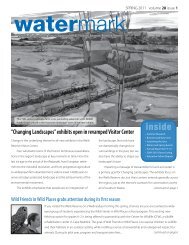Management Plan - National Estuarine Research Reserve System
Management Plan - National Estuarine Research Reserve System
Management Plan - National Estuarine Research Reserve System
Create successful ePaper yourself
Turn your PDF publications into a flip-book with our unique Google optimized e-Paper software.
forests, and wetlands. It has habitat for a range ofwildlife species. Protection of this parcel wouldincrease the amount of contiguous publicly ownedland in the area of the <strong>Reserve</strong>.Adjacent Parcels along <strong>Estuarine</strong> Areas: Whilemost of the Little and Webhannet Rivers’ estuaries,salt marshes, and adjacent uplands are either alreadyprotected or developed, there still are opportunitiesfor conservation. Development of remaining parcelsor the more intensive development of existing landswould degrade impact the resources of the <strong>Reserve</strong>through loss of habitat and increased non-pointsource pollution. These lands lie east of U.S. Route1 and adjoin conservation land owned by the Townof Wells, the Maine Department of Conservation,or Rachel Carson <strong>National</strong> Wildlife Refuge. Theseare mostly upland parcels that help buffer freshwatersections of the Merriland River and estuarineand salt marshes of the Webhannet River.Focus Areas on Little River andWebhannet RiverThe Wells <strong>Reserve</strong> manages part of the longestsystem of interconnected barrier beach salt marshsystems in the state. Substantial portions of thewaterways that drain into these marshes are surprisinglyhealthy and intact. But the WebhannetRiver, the Merriland River, Branch Brook, and theOgunquit River flow through a landscape that isunder threat from development. Protecting thesemajor rivers is a priority is a priority for the <strong>Reserve</strong>and its partners. They intend to create natural corridorsthat connect protected coastal areas to uplandareas at the headwaters of these rivers.Focus Area #1 — Little River WatershedThe Merriland River and Branch Brook are themajor tributaries to the Little River. Currently,4,332 acres of the 20,176 acres comprising thiswatershed have been conserved. For improvedresource protection, additional riparian habitatsand wildlife corridors should be protected withinthe Little River watershed.One potential corridor that merits protection followsBranch Brook. The brook’s headwaters areat the Kennebunk Plains in the towns of Sanfordand Kennebunk. The Plains provide habitat for rareand threatened plants and grassland-nesting birds.More than 90 percent of the global population of thenorthern blazing star is found there. For decades, thisrare sandplain grassland has been the focus of landacquisition by The Nature Conservancy, the State ofMaine, and the Kennebunk/Kennebunkport/WellsWater District. Branch Brook flows from the Plainsthrough a 1,947-acre parcel owned by the K/K/WWater District to the Rachel Carson NWR and theWells <strong>Reserve</strong>. This protected corridor is broken bya 78-acre parcel directly across U.S. Route 1 from258 acres of refuge land. This parcel is a priority foracquisition to prevent isolating the Wells <strong>Reserve</strong>from the rest of the Little River watershed.A second potential corridor follows the MerrilandRiver. The river’s headwaters are located in andnear the Fenderson Wildlife Commons, a 500-acre parcel protected by the Wells ConservationCommission. Fenderson Commons is part of a1,200-acre forested, roadless wetland supportingdiverse community types, including an extremelyunusual savanna-like community that features a redmaple canopy over sedge meadow ground cover.Fenderson Commons holds an uncommonly richand varied system of freshwater wetlands, includingsphagnum bog, vernal pool, four-season flowingsprings, red maple swamp, marsh, and river.Subsurficial water resources may provide a significantsource of drinking water, and the MerrilandRiver with its feeder streams is a top-rated brooktrout fishery.Fenderson Commons also holds a significant standof white pines in the 90-100 foot range accompaniedby mature oak and maple. Because of the patternof human use and abandonment, beginning with“commons” pasturage of stock in the mid 1600’s,the area provides possibilities for research in historicalhuman ecology. Additions to the Fenderson<strong>Management</strong> <strong>Plan</strong>: <strong>Reserve</strong> Boundaries and Acquisitions105




